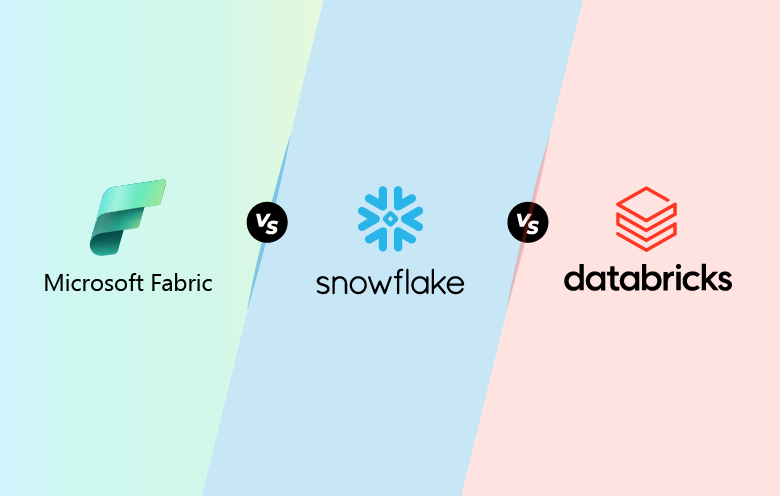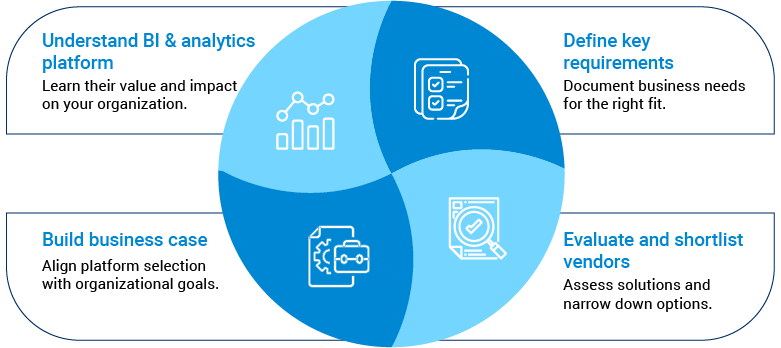

Data is your competitive advantage—but only if you choose the right platform. Choosing the right data analytics platform is an important decision that can highly influence the efficiency of an organization and the ultimate strategic outcomes. Decision-makers base their decision to choose the best data management platform based on several factors, including:
- The complexity of business requirements
- The scale of data operations
- And the level of stakeholder involvement
Microsoft Fabric, Databricks, and Snowflake each promise cutting-edge analytics. However, making the wrong choice could mean skyrocketing costs, underutilized capabilities, or data silos that hinder decision making.
Looking for Microsoft Fabric consulting?
Leverage the power of a unified data analytics platform. Our Microsoft-certified engineers help you implement the full potential of Fabric.

Do you need real-time AI-driven insights, enterprise-grade governance, or cloud-native scalability? This comparison isn’t just about features—it’s about defining your data strategy for the next decade. Let’s break down which platform truly aligns with your business vision.
Factors to consider for selecting the right data platform

Understand BI and analytics platform:
Gain an in-depth understanding of what business intelligence and analytics platforms are, and the value they can create for the organization.
Build business case:
Formulation of a convincing argument to choose a BI and analytics platform, and it must be aligned with the organizational goals and objectives.
Define key requirements:
identify and document business needs to ensure the selected platform meets these requirements.
Evaluate and shortlist vendors:
It involves examining the BI and analytics solution space and evaluating possibilities; then narrow it down into shortlisted potential suppliers.
What is Microsoft Fabric and what are its key features?
Microsoft Fabric combines data engineering, analytics, and visualization into one platform. It is built on OneLake architecture and combines capabilities of Power BI, Synapse, and Azure Data Factory. It is therefore a seamless ecosystem for organizations already leveraging Microsoft products.
Key features of Microsoft Fabric
- Unified experience: It unifies ETL, data warehousing, and business intelligence in one platform.
- Built-in AI capabilities: This includes generative AI tools that can automate insights.
- Simplified governance: Single governance layer, which incorporates both security and compliance.
- Power BI integration: Real-time analytics and visualization tool embedded natively.
How Softweb streamlined data operations for a leading energy company with Microsoft Fabric
A major US-based energy company streamlined data management with Microsoft Fabric integration. They achieved the following benefits:
- Unified data sources
- Real-time analytics
- Cost savings
- Improved regulatory compliance

What is Databricks and what are its key features?
Databricks specializes in big data processing and machine learning. It is built for organizations that require robust analytics on unstructured and structured data. With Lakehouse architecture, Databricks combines data lakes and warehouses in one single framework for advanced analytics.
Key features of Databricks
- Lakehouse architecture: Facilitates unified data storage along with analytics.
- Supports ML and AI: Optimized for data science workloads and training of ML models.
- Scalable compute: Has Spark-based processing for massive volumes of data.
- Collaborative environment: Allows teamwork using notebooks.
What is Snowflake and what are its key features?
Snowflake has redefined data warehousing with its cloud-
native approach. It focuses on scalability, ease of use, and cross-cloud compatibility, making it a strong contender for enterprises with diverse data and analytics requirements.
Key features of Snowflake
- Multi-cloud compatibility: Operates on AWS, Azure, and Google Cloud seamlessly.
- Elastic scalability: Instantly adjusts compute and storage resources.
- Data sharing: Advanced capabilities for real-time data collaboration.
- Zero maintenance: Fully managed platform requiring minimal operational overhead.
Fabric vs Databricks vs Snowflake: A detailed comparison
| Feature | Microsoft Fabric | Databricks | Snowflake |
|---|---|---|---|
| Core focus | Unified data platform | Big data and ML analytics | Cloud data warehousing |
| AI/ML capabilities | Integrated but basic | Advanced | Limited but expanding |
| Ease of use | High (Microsoft tools) | Moderate (for experts) | High |
| Performance | Best for Microsoft users | Superior for ML workloads | Excellent for analytics |
| Governance | Strong | Moderate | Strong |
| Cost flexibility | Pay-as-you-go | Variable with workloads | Consumption-based |
Architecture comparison of Fabric, Databricks, and Snowflake
| Feature | Microsoft Fabric | Databricks | Snowflake |
|---|---|---|---|
| Core architecture | OneLake (Unified Data Platform) | Lakehouse architecture | Multi-cluster shared data |
| Data management | Integrated data pipeline, storage, and analytics | Delta Lake (ACID transactions) | Data warehouse with separation of compute and storage |
| Data processing engine | Azure Synapse, Power BI | Apache Spark | Snowflake Engine (optimized SQL) |
| Compute scalability | Dependent on Azure infrastructure | Elastic with Spark | Independent (Compute/Storage) |
| Cloud compatibility | Primarily Azure | AWS, Azure, Google Cloud | AWS, Azure, Google Cloud |
Concise comparison of pros and cons of Microsoft Fabric, Databricks, and Snowflake
| Tool | Pros | Cons |
|---|---|---|
| Microsoft Fabric | Seamless integration with Microsoft tools (Azure, Power BI), unified data management, built-in AI features | Primarily suited for Microsoft-centric environments, limited for non-Microsoft users |
| Databricks | Advanced big data processing, ML and AI integration, real-time analytics with Lakehouse architecture | Can be complex and costly, especially for smaller teams or simpler workloads |
| Snowflake | Multi-cloud support, scalable storage and compute, user-friendly for data analysts | Limited ML capabilities, higher cost at scale, less flexibility for complex analytics |
Which data management platform is best for your organization?
Let’s consider the following criteria:
Ecosystem alignment
- Do you already have a Microsoft technology such as Azure or Power BI? Go with Microsoft Fabric.
- Which one do you prefer, using open-source framework or custom model? Choose Databricks.
- Need seamless multi-cloud operations? Look for Snowflake.
Workload type
- Microsoft Fabric stands out as unmatched for data visualization and operational reporting.
- Databricks is where to go when building predictive models or handling big datasets.
- For high-speed queries on structured data, Snowflake provides excellent performance.
Scalability and costs
- Fabric provides cost-effective solutions for businesses already on Azure.
- Databricks scales really well for high-computational projects, though it can be pricey for smaller projects.
- Snowflake’s consumption-based pricing really allows to pay only for what’s used, which makes it a killer for variable workloads.
Governance and security
- Fabric provides centralized governance with compliance tools that are tailored for enterprise needs.
- Databricks delivers average governance but brings great knowledge sharing.
- Snowflake is the leader in secure data sharing and granular access controls.
Cost analysis
Microsoft Fabric
Cost-effective for organizations already using the Microsoft ecosystem. Pay-as-you-go model with easy integration advantages but potentially higher costs for non-Microsoft tools.
Databricks
Expensive, especially for small to mid-sized businesses, because of its data processing power and ML/AI capabilities. Pricing is based on compute usage and storage.
Snowflake
Scalable with consumption-based pricing. This means – at a smaller scale, it might be relatively cost-effective, but as data grows, the cost increases because of high storage and compute requirements.
Choose the best data platform with the help of a data analytics consulting company
No single platform fits every need, so align your choice with your organizational goals. Fabric is perfect for simplifying workflows within a Microsoft ecosystem. Databricks shines for innovation in AI and big data analytics. Snowflake offers unmatched simplicity and performance for cloud-native data warehousing. Evaluate your current and future requirements to select a solution that not only solves today’s challenges but also scales with your ambitions.
Experienced data analytics consulting services provider can guide your platform choice seamlessly. From the best Microsoft Fabric, Databricks, and Snowflake expertise to tailor-made solutions and best practice implementation, we can take your data strategy to the next level. Need help implementing the right platform? Let’s talk!
AI Workshop
Envision how your AI Journey can be in next 1-3 years from adoption and acceleration perspective.
Enroll NowNeed Help ?
We are here for you